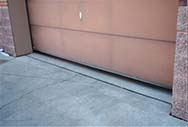Wildlife in the Garage or Shed
CLICK HERE for a print-friendly PDF and photos!
Situation:
A wild animal is inside of your garage or shed.
Why This Happens:
An animal will sometimes wander into a garage or shed looking for food or shelter if the door is left open.
They can gain entry through holes in the structure’s walls, roof, or foundation that are caused by water-damage or missing boards, siding, or shingles, or broken windows.
Birds like American Robins or Barn Swallows, looking for a safe place to nest, sometimes will go into a garage or shed through an open door or a broken window.
FAQs & Humane Solutions:
“I forgot to close my garage door last night and now I have an opossum (or raccoon, or skunk, etc.) inside the garage. What should I do?”
If you leave the garage door open for a few hours, the animal will usually leave on its own. However, for a nocturnal (night-active) animal like an opossum, raccoon, or skunk, the animal will probably not leave until after dark. If you can’t leave your garage door wide open for security reasons, you may try lowering the garage door to within about 4 to 6 inches of the pavement. Then disable the garage door opener or block the door track so someone can’t raise the door from the outside. This should allow the animal enough room under the door to get out. If the animal has not left after a day or two, hazing methods could be used to coax the animal out (tips below).
“A chipmunk (or other rodent) keeps chewing their way into my garage by gnawing on the garage doors. What can I do to keep them out?”
- Keep any food stored in the garage, like bird seed or grass seed, in metal containers to keep rodents from getting to it, and clean up any spilled seed right away.
- Spray a liquid non-toxic taste-repellent like “bitter apple” on the edge of the door and any other surface you don’t want the animal(s) to chew on. Bitter apple spray is available at most pet supply stores.
- Instead of applying a repellent, you can use staples, or short screws and fender washers to attach sheet-metal edging or hardware cloth on door edges and door frames to stop animals from chewing.
- Consider installing a rodent-proof garage door sweep. These sturdy sweeps have a metal backer that prevents rodents from chewing through the otherwise flimsy rubber.
“I’ve got a raccoon (or opossum, or squirrel, etc.) living in my shed (or garage). I haven’t left the door open at all, so they must be getting in some other way. What can I do to get them to leave?”
Note: the techniques below do not apply to situations involving bats.
You can do what we call “hazing” to get the animal to leave. Hazing involves temporarily converting that dark, safe, quiet wildlife haven inside your garage or shed into a bright, noisy, smelly area in which the animal no longer feels comfortable or safe. The supplies that will be needed are: a bright light such as a mechanic's trouble light or a floodlight, a portable radio, and some type of non-toxic animal repellent such as Critter Ridder® or Expel®, or rags drenched in household ammonia.
Securely set up the light inside the structure about five feet away from the entrance hole and turn it on, shining toward the entrance hole. Caution: keep power cords away from the entrance itself or the animal may gnaw on the cord! Keep the light itself away from flammable materials. Place the radio in the garage or shed, preferably close to the animal's “den” or about five feet away from the entrance hole. Tune the radio to a talk station or a rock-and-roll station and have it on a moderately-loud volume (not loud enough to anger your neighbors or keep your family from getting to sleep at night). Place rags drenched in household ammonia or the animal repellent in the animal’s entrance hole or sprinkle the Critter Ridder there instead. The animal might leave the first night you do this, but you’ll probably need to keep this up for three days in a row, or perhaps longer. You can turn the radio off or turn the volume down periodically if the noise gets to be too much for you or your neighbors. The ammonia on the rags will evaporate, so you may need to re-wet them with fresh ammonia once or twice a day.
“Once I have done the hazing, how do I know if the animal is gone?”
To determine if the animal is gone, loosely crumple newspaper into a ball and place it in the animal’s entry hole into the garage or shed. If the newspaper is not disturbed after three days, the animal MAY have moved out. However, this method is only reliable if there is no other place that the animal can get into the garage or shed. Caution: be very careful using this technique to detect animal activity during the late fall, winter, and early spring. Some animals hibernate and others greatly reduce their activity and “hole-up” in a safe, relatively warm place for days or even weeks at a time when it is very cold. Do not do permanent repairs or install an animal-proof barrier (more about this below) until you are SURE that no animals will be trapped inside!
Another option for checking to see if the animal has left is a “trail camera.” These weather-resistant digital cameras automatically take a photo(s) or a clip of digital video when something passes in front of the camera. These cameras are sold at sporting-goods stores and online. The camera should be placed so that it will be triggered by an animal going in or out from the opening in the structure.
“Once the animal has left, how can I prevent it or another animal from getting back inside the garage (or shed)?”
You are right, once this animal leaves and the hazing stops, if you don’t “animal-proof” the area, you are very likely to have another animal move in. By “animal-proofing,” we mean installing a barrier that animals cannot chew through, pull apart, dig under, or climb over. Welded wire mesh or hardware cloth are usually good choices for this, since they are strong, long-lasting, easy to work with, are relatively inexpensive and, except for welded wire mesh, are readily available at most hardware stores and home improvement centers. Welded wire mesh can be a little more challenging to find, but it is available from some farm-and-ranch supply stores, fencing retailers, and online. If you are shopping for welded wire mesh, look for 1” x 1” galvanized mesh made with 16 gauge wire.
Materials you will need:
- Galvanized hardware cloth or welded wire mesh
- Screws – we like 1 ¼” galvanized pan-head lath screws, but drywall screws should also work
- Fender washers – we like 1” diameter washers with a 3/16” hole
Tools you will need:
- Safety glasses
- Leather gloves – to protect your hands from possibly sharp metal edges
- Cordless or corded drill/screwdriver with appropriate bit for driving the screws you will be using
- Wire cutter, or sheet metal cutting shears (the latter works well for hardware cloth)
- Optional – for large jobs, you may want to rent an electric sheet-metal and wire-mesh cutting shears. Or for cutting welded wire mesh, use an electric reciprocating saw with a metal-cutting blade to speed-up the mesh-cutting process.
Instructions:
- Cut the mesh to fit. Measure the width and length of the piece(s) of mesh you’ll need. Make the piece of mesh a few inches in each direction larger than the hole. Cut the piece and fit it into place. Trim and/or bend the piece as needed until it fits properly.
- Install the wire mesh. Use the drill/driver to install the mesh to the structure over the hole using the lath screws and fender washers. To do this, hold the mesh in place and drive the screw through a washer to anchor the mesh to the structure. Use as many screws and washers as are needed to securely hold the mesh in place.
- Animal-proof other possible entry points. With the entry hole covered, animals may look for othe r weak points on your structure that they can use to get inside. These weak points are often areas of water-damaged or rotted wood, loose trim boards or siding, and flimsy or missing vent covers. Proactively install wire mesh over these areas to keep animals from gnawing through or tearing open these weakened spots. Pay careful attention to corners – anywhere that two walls or panels meet -- such as under overhangs, outside corners of the fascia, where gables meet the roofline, etc.
- After you’ve repaired and animal-proofed your garage or shed, check back at least twice a day for the next three days to make sure that no animals have accidentally been closed inside and are unable to get out! If an animal appears to be desperately and persistently trying to get back in the structure, it may be a mother animal with babies still inside. In this case, temporarily remove the mesh you installed over the entrance hole. Not being able to get to her babies for a short time because of the animal-proofing you’ve installed is usually enough to get a mom animal to move her young elsewhere. Resume the hazing techniques and give her another day or two to move her family out.
“I like to leave my garage door open during the day, but today, a Robin (or sparrow, or other bird) flew in there and can’t seem to find its way out. What should I do?”
Open any windows, or if the windows don’t open, cover them with a blanket, sheet, towel, cardboard, or thick paper so the bird doesn’t mistake the window for an exit and collide with the glass. Then turn off the garage lights and open the garage door. The only light left will be coming from the outside through the garage door. Keep people, pets and noisy activities away from the garage door so the bird will not be too afraid to fly out. Given some time, a bird will usually fly toward the light and out the open door.
However, for most birds “up” means safety, so if the bird stays up high in the rafters and doesn’t seem to want to come down to fly out the door, tie or tape a brightly-colored or white cloth or piece of paper on a long stick to make a “flag.” Reach up with the flag on the long stick above the bird to get the bird to fly downward away from the flag. Once the bird comes down out of the rafters it will usually see the open door and fly out.
For seed-eating birds like sparrows, cardinals, doves, and pigeons, you can place a small pile of bird seed on the floor just inside or just outside the open door. Often, if left alone, the bird will fly down to the seed, and then fly out of the door.
“I like to leave my garage (or shed) door open during the day, but today, a Robin (or other bird) flew in and started to build a nest. What should I do?”
If the bird has just started carrying in material for a nest but hasn’t yet laid eggs, you can wait for the bird to leave to get more nest material or find food and then close the garage door. The birds will find another place to nest and start over. You’ll need to keep your garage door closed during the day for the rest of the nesting season to keep birds out.
If you are not worried about leaving your door open at night, you can let the birds nest there and close the door after their young have left the nest.
If there are eggs or young in the nest, birds (other than House Sparrows, European Starlings, and Rock Pigeons) and their nests and eggs are protected by state and/federal laws and you can’t legally disturb them. If you are in Milwaukee County, you are welcome to call us for further advice at 414-431-6204. If you are outside of Milwaukee County, please call your local, licensed wildlife rehabilitator for advice.
"I am unable to humanely haze the animal out of my garage/shed or repair my garage/shed to prevent animals from re-entering. Will you do it for it for me?"
We function as a non-profit wildlife hospital and do not have the resources to provide those services. There is the option, however, to hire a humane animal removal company to do the work for you. For more information on choosing the right company for the job, click here.

.png)

